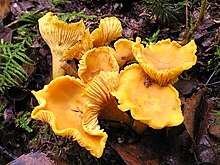Cantharellus cibarius
| Cantharellus cibarius | |
|---|---|

| |
| Scientific classification | |
| Kingdom: | Fungi |
| Division: | Basidiomycota |
| Class: | Agaricomycetes |
| Order: | Cantharellales |
| Family: | Cantharellaceae |
| Genus: | Cantharellus |
| Species: | C. cibarius
|
| Binomial name | |
| Cantharellus cibarius Fr. (1821)
| |
| Synonyms | |
| Cantharellus cibarius | |
|---|---|
| ridges on hymenium | |
| cap is infundibuliform | |
| hymenium is decurrent | |
| stipe is bare | |
| spore print is yellow to cream | |
| ecology is mycorrhizal | |
| edibility: choice | |
Cantharellus cibarius (Latin: cantharellus, "chanterelle"; cibarius, "culinary")[2] is a species of golden chanterelle mushroom in the genus Cantharellus. It is also known as girolle (or girole).[3][4] It grows in Europe from Scandinavia to the Mediterranean Basin, mainly in deciduous and coniferous forests.[3][5][6][7] Due to its characteristic color and shape, it is easy to distinguish from mushrooms with potential toxicity that discourage human consumption. A commonly eaten and favored mushroom, the chanterelle is typically harvested from late summer to late fall in its European distribution.[3]
Chanterelles are used in many culinary dishes,[3][5] and can be preserved by either drying or freezing. An oven should not be used when drying it because can result in the mushroom becoming bitter.[3]
Taxonomy[]
At one time, all yellow or golden chanterelles in North America had been classified as Cantharellus cibarius. Using DNA analysis, they have since been shown to be a group of related species known as the Cantharellus cibarius group or species complex, with C. cibarius sensu stricto restricted to Europe.[6][7][8] In 1997, the Pacific golden chanterelle (C. formosus) and C. cibarius var. roseocanus were identified,[9] followed by C. cascadensis in 2003[10] and C. californicus in 2008.[11]
Description[]
The mushroom is easy to detect and recognize in nature.[3] The body is 3–10 centimetres (1–4 inches) wide and 5–10 cm (2–4 in) tall. The color varies from yellow to dark yellow.[3][5] Red spots will appear on the cap of the mushroom if it is damaged.[12] Chanterelle mushrooms have a faint aroma and flavour of apricots.[3][5]
Care should be taken not to confuse this species with the deadly Omphalotus illudens.[13]
References[]
- ^ "Cantharellus cibarius Fr. 1821". MycoBank. International Mycological Association.
- ^ "cibarius - Wiktionary". en.wiktionary.org. Retrieved 2019-08-31.
- ^ Jump up to: a b c d e f g h "Cantharellus cibarius Fr. - Chanterelle". First Nature. 2020. Retrieved 27 January 2020.
- ^ "Golden chanterelle (girolle)". Missouri Department of Conservation. 2020. Retrieved 27 January 2020.
- ^ Jump up to: a b c d Dyson Forbes (13 April 2017). "Learn about chanterelle mushrooms". Forbes Wild Foods. Retrieved 27 January 2020.
- ^ Jump up to: a b Kuo, Michael. "Cantharellus "cibarius"". mushroomexpert.com. Retrieved 2018-09-01.
- ^ Jump up to: a b Buyck, Bart; Hofstetter, Valérie; Olariaga, Ibai (September 2016). "Setting the Record Straight on North American Cantharellus". Cryptogamie, Mycologie. 37 (3): 405–417. doi:10.7872/crym/v37.iss3.2016.405. S2CID 89596664.
- ^ Thorn, R. Greg; Kim, Jee In; Lebeuf, Renée; Voitk, Andrus (June 2017). "The golden chanterelles of Newfoundland and Labrador: a new species, a new record for North America, and a lost species rediscovered" (PDF). Botany. 95 (6): 547–560. doi:10.1139/cjb-2016-0213. Retrieved 2 October 2019.
- ^ Redhead, S.A.; Norvell, L.L.; Danell, E. (1997). "Cantharellus formosus and the Pacific Golden Chanterelle harvest in Western North America". Mycotaxon. 65: 285–322.
- ^ Dunham, S.M.; O'Dell, T.E.; Molina, R. (2003). "Analysis of nrDNA sequences and microsatellite allele frequencies reveals a cryptic chanterelle species Cantharellus cascadensis sp. nov. from the American Pacific Northwest". Mycological Research. 107 (10): 1163–77. doi:10.1017/s0953756203008475. PMID 14635765.
- ^ Arora, D.; Dunham, S.M. (2008). "A new, commercially valuable chanterelle species, Cantharellus californicus sp. nov., associated with live oak in California, USA" (PDF). Economic Botany. 62 (3): 376–91. doi:10.1007/s12231-008-9042-7. S2CID 19220345.
- ^ "Cantharellus "cibarius" (MushroomExpert.Com)". www.mushroomexpert.com. Retrieved 2019-10-22.
- ^ Phillips, Roger (2010). Mushrooms and Other Fungi of North America. Buffalo, NY: Firefly Books. p. 248. ISBN 978-1-55407-651-2.
 Media related to Cantharellus cibarius at Wikimedia Commons
Media related to Cantharellus cibarius at Wikimedia Commons
- Cantharellus
- Edible fungi
- Fungi in cultivation
- Fungi of Europe
- Fungi described in 1821